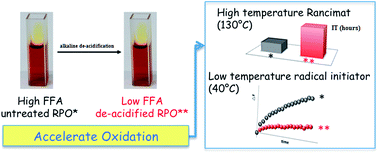Influence of free fatty acid content on the oxidative stability of red palm oil†
Abstract
The role of free fatty acids (FFA) on the oxidative stability of four different unrefined red palm oils (RPO) has been investigated. Unrefined red palm oil is a typical African edible oil produced by laborious and traditional methods that heavily affect the final product quality. Physicochemical analysis performed on the RPO samples showed a high FFA content (8.3–14.5%), peroxide values between 2.9 and 10.8 meq O2 per kg and a significant presence of carotenoids (up to 1.6 g kg−1). In order to lower the FFA content, the oil was de-acidified (RPO-D) and the treated product resulted with an improved quality when compared with the untreated oil (RPO-U). The de-acidification route, as well as the reduction of the acidity level, caused a reduction in the UV spectrophotometric indices (K232 and K270) whereas the DOBI index increased and both peroxide and carotenoids amounts were unaffected. Furthermore, the oxidation stability of RPO-U and RPO-D was evaluated using two different experimental approaches: a high-temperature method (Rancimat method) and medium-temperature method (reaction induced by the radical initiator, 2,2′-azobis(2,4-dimethylvaleronitrile)). Both methods unequivocally showed a significant improvement in the resistance to oxidation of RPO-D when compared to RPO-U and confirmed the crucial pro-oxidant effect of FFA on red palm oil.



 Please wait while we load your content...
Please wait while we load your content...